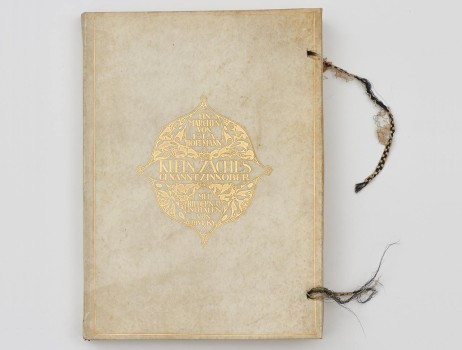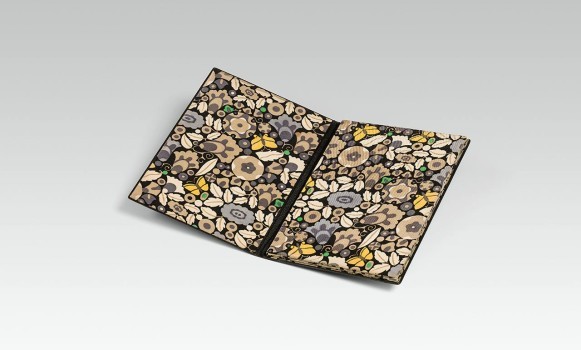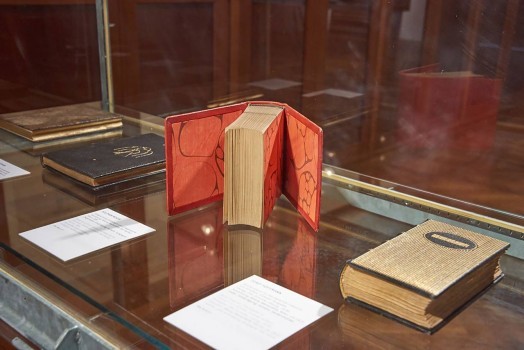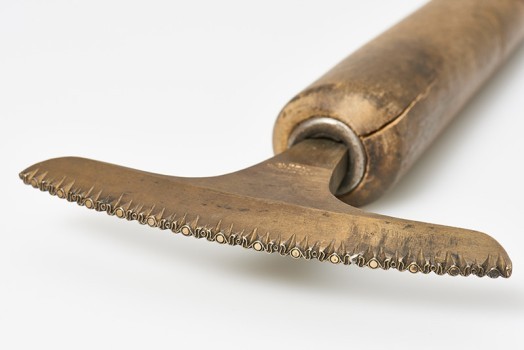Book Covers Of The Wiener Werkstätte
08 Mar - 28 May 2017
BOOK COVERS OF THE WIENER WERKSTÄTTE
8 March – 28 May 2017
Guest Curator: Ernst Ploil
Curators: Elisabeth Schmuttermeier, Curator, MAK Metal Collection and Wiener Werkstätte Archive; Maria-Luise Jesch, Assistance, MAK Metal Collection and Wiener Werkstätte Archive
Ensuing from the English Arts & Crafts Movement, Viennese artists also advocated the redesign of book covers around 1900. Great strides were made in this area by the Wiener Werkstätte (1903–1932) under the designers Koloman Moser (1868–1918) and Josef Hoffmann (1870–1956). The artists’ endeavors were supported by Carl (Karl) Beitel (1866–1917), who was known in Vienna to be a superb bookbinder and who, as a master, oversaw the Wiener Werkstätte’s bookbinding atelier from May 1904.
The first books were bound in marbled paper made by the workshop itself. At the same time, both Moser and Hoffmann designed book covers in leather. Mostly kid leather (morocco) was used for this purpose, either with a heavier, more granular texture or with a smooth surface. Occasionally crocodile, snake, frog, lizard, and undulate ray skins or fabrics were also used.
Among the richly decorated or simply designed bindings, the prevailing design principle was geometrization. The leather stamps available at the workshops provided the means to combine a wide range of highly diverse shapes. Parallel lines, squares, rhombuses, ellipses, circles, ovals, spirals, tendrils, as well as stylized leaves, flowers, and fruits were the favored motifs to cover the bindings entirely or feature on them as a single decorative element. Sometimes the design of the book cover took into account the book’s content, with the external style making reference to the internal storyline.
As the 1910s drew to an end, the motifs used for book cover designs became more playful and opulent—female artists in particular created hand-painted, partly embossed or stamped bindings. From 1924 Hoffmann used wave profiles for his book covers; somewhat later, profiled, geometric wooden grids were applied, which were then covered in leather.
Although it may seem surprising from a modern-day perspective that bibliophiles in the past could be so dissatisfied with publisher’s editions that they would actually commission artists to design new book covers for their purchases, in the first third of the 20th century that was an entirely common practice. Indeed, over 300 book covers were designed at the Wiener Werkstätte between 1904 and 1929.
With the aid of the objects from private collections—particularly the Ernst Ploil and Richard Grubman Collections—as well as from the MAK Collection that are on display in the exhibition BOOK COVERS OF THE WIENER WERKSTÄTTE, it is possible to demonstrate the tremendous abundance of ideas and the diverse craft techniques that are so characteristic of the book covers of the Wiener Werkstätte.
8 March – 28 May 2017
Guest Curator: Ernst Ploil
Curators: Elisabeth Schmuttermeier, Curator, MAK Metal Collection and Wiener Werkstätte Archive; Maria-Luise Jesch, Assistance, MAK Metal Collection and Wiener Werkstätte Archive
Ensuing from the English Arts & Crafts Movement, Viennese artists also advocated the redesign of book covers around 1900. Great strides were made in this area by the Wiener Werkstätte (1903–1932) under the designers Koloman Moser (1868–1918) and Josef Hoffmann (1870–1956). The artists’ endeavors were supported by Carl (Karl) Beitel (1866–1917), who was known in Vienna to be a superb bookbinder and who, as a master, oversaw the Wiener Werkstätte’s bookbinding atelier from May 1904.
The first books were bound in marbled paper made by the workshop itself. At the same time, both Moser and Hoffmann designed book covers in leather. Mostly kid leather (morocco) was used for this purpose, either with a heavier, more granular texture or with a smooth surface. Occasionally crocodile, snake, frog, lizard, and undulate ray skins or fabrics were also used.
Among the richly decorated or simply designed bindings, the prevailing design principle was geometrization. The leather stamps available at the workshops provided the means to combine a wide range of highly diverse shapes. Parallel lines, squares, rhombuses, ellipses, circles, ovals, spirals, tendrils, as well as stylized leaves, flowers, and fruits were the favored motifs to cover the bindings entirely or feature on them as a single decorative element. Sometimes the design of the book cover took into account the book’s content, with the external style making reference to the internal storyline.
As the 1910s drew to an end, the motifs used for book cover designs became more playful and opulent—female artists in particular created hand-painted, partly embossed or stamped bindings. From 1924 Hoffmann used wave profiles for his book covers; somewhat later, profiled, geometric wooden grids were applied, which were then covered in leather.
Although it may seem surprising from a modern-day perspective that bibliophiles in the past could be so dissatisfied with publisher’s editions that they would actually commission artists to design new book covers for their purchases, in the first third of the 20th century that was an entirely common practice. Indeed, over 300 book covers were designed at the Wiener Werkstätte between 1904 and 1929.
With the aid of the objects from private collections—particularly the Ernst Ploil and Richard Grubman Collections—as well as from the MAK Collection that are on display in the exhibition BOOK COVERS OF THE WIENER WERKSTÄTTE, it is possible to demonstrate the tremendous abundance of ideas and the diverse craft techniques that are so characteristic of the book covers of the Wiener Werkstätte.







